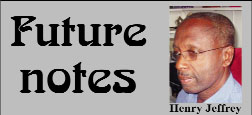On 6 October 2016, Stabroek News published an article ‘Cabinet deeply perturbed at Grade Six math results’, the content of which, if true, has certainly taken official education reporting to a new low, and this is magnified by the hackneyed solutions to the problem that are proffered. How could anyone, much less the cabinet, claim that a situation of ‘extreme urgency and grave national importance’ exists without at the very least properly describing for stakeholders what that situation is?
 Furthermore, I looked in vain at the suggested solutions emanating from the cabinet to try and glean the nature of the ‘crisis’, only to find the commonplace. ‘Those steps would include remedial training of teachers, better and more varied text books, more teaching aids and better use of technology in the delivery of education.’ And according to the minister of education, he would ‘like to see a little bit more concentration, more work and I would like to see teachers in the classrooms, really ensuring that their curriculums are delivered and received by the students and above all, I want to really lift the level of the education system. I think there is still a great deal to be done!’
Furthermore, I looked in vain at the suggested solutions emanating from the cabinet to try and glean the nature of the ‘crisis’, only to find the commonplace. ‘Those steps would include remedial training of teachers, better and more varied text books, more teaching aids and better use of technology in the delivery of education.’ And according to the minister of education, he would ‘like to see a little bit more concentration, more work and I would like to see teachers in the classrooms, really ensuring that their curriculums are delivered and received by the students and above all, I want to really lift the level of the education system. I think there is still a great deal to be done!’
Year after year, the previous government, bent upon hoodwinking the public that the education system was better than it actually was, provided inadequate analyses that failed to properly locate the education system comparatively across time, countries, type of school (private and public), inputs and outputs, etc. For instance, in relation to the Caribbean Examinations Council’s Secondary Education Certificate, because Guyana is usually at the bottom of the country comparisons table, the regime masked this fact by focusing on the few high achievers.
For the most part, the media usually snatched upon the popular human interest content of this type of reporting without in parallel requiring more substantial statistical analysis. This tactic has been so successful that today reasonable people can be heard claiming that Guyana has one of the best education systems in the Caribbean!
Nevertheless, that government did provide some statistical analysis, which caused the writer of the SN article to be nostalgic: ‘Back in 2014, then Education Minister Priya Manickchand had said that Mathematics remained a major concern, with a decline from a pass rate of 43.94% in 2013 to 31.52% among the 15,227 candidates who sat the examinations that year. She had also noted a decline of 9.6% among boys in Mathematics and 11.6% among the girls. That year an analysis of the performance was made public. Nothing has been released since then.’
Of course, these are largely meaningless numbers, for one cannot properly make a case for decline, or improvement for that matter, by comparing only two years, particularly when there are decades’ worth of experiences and a one year deviation from the norm proves little in terms of trend analysis.
To highlight the point, grades 1 to 3 passes in maths at CXC improved from 17.9% in 1998 (the year CXC reformed the grading system) to 30.2% in 2005 and 38.37% in 2016. Put in this manner, it is quite clear that progress, albeit perhaps slower than some require, is being made. But in 2015 the pass rate was 45.07%, only to fall back to what was perhaps the norm of 38.7% in 2014. In about 2004, to the joy of many, grades 1 to 3 passes in English language jumped to about 60% and I had to spend a great deal of time trying to dampen expectations for an outcome that was clearly not sustainable: the rate fell back to the norm of about 52% in 2005.
Just after the grade six results were announced, asked by SN whether an analysis of student performance would be made public, the then Chief Education Officer demurred, claiming that the reports are for schools. Since no analysis was presented by cabinet to support its position that a ‘crisis’ exists, apparently that position remains.
What possible negative impact can it have on the schools if you give the performance statistics to the public? Indeed, I can see only positives, for, among other things, for decades the MOE has been trying to improve stakeholders’ involvement, so why not disaggregate the numbers, let them know which schools are doing well and which badly, so that local pressure might help to improve performance? Furthermore, how else can a government that has established a national inquiry into the education system expect the public to sensibly participate without adequate information?
The coalition government should note that by giving a premium to making propaganda and thus thwarting open public discourse, the PPP/C largely concealed the fact that it was making reasonable progress in education inputs and outputs! Until the public is supplied with better information it will rely upon anecdotal analyses and succumb to highly emotional responses. One would have expected that this government with all its talk about inclusiveness and public participation would have improved upon the situation left by the PPP/C. Instead, the little that was given is now being taken away.
PPP/C went low but APNU+AFC has gone lower!
henryjeffrey@yahoo.com





